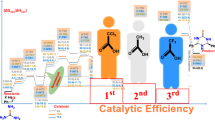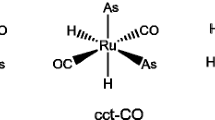Abstract
Theoretical investigations have been carried out using density functional theory, with the M06L functional and SMD solvent-modeling, to study the binding interactions of geometrical cis-trans isomers of fumarate (fum2−), maleate (male2−) and 1,2-cyclopropane dicarboxylate with Cu2+- and Zn2+-based dinuclear cryptates. It was found that cis-trans isomers of these groups of compounds bind strongly to metal cryptates, and the binding ability of the cryptates is controlled by the shape of the ‘incoming’ isomer (cis or trans); trans isomers bind more strongly than cis. Due to the size and shape of the cis and trans isomers, the cryptates can bind selectively and, to a large extent, ‘recognize’ the various cis-trans isomers, suggesting the tantalising possibility of isomeric separation/purification and recognition.

Density functional theory calculations have been used to study the binding interactions of geometrical cis-trans isomers of fumarate (fum2−), maleate (male2−) and 1,2-cyclopropane dicarboxilate with Cu2+- and Zn2+-based dinuclear cryptates; Cu-based cryptate bound complexes are shown here. Cis-trans isomers bind strongly, and this is controlled by the shape of the ‘incoming’ isomer (cis or trans); trans isomers bind more strongly than cis. Binding is selective with ‘recognition’ of various cis-trans isomers.




Similar content being viewed by others
References
Lehn JM, Sauvage JP (1971) J Chem Soc Chem Commun 440–441
Lehn JM (1980) Pure Appl Chem 52:2441
Lehn JM, Pine SH, Watanabe EI, Willard AC (1977) J Am Chem Soc 99:6755
Motekaitis RJ, Martell AE, Lehn JM, Watanabe EI (1982) Inorg Chem 21:4253
Arnaud-Neu F, Fuangswasdi S, Maubert B, Nelson J, McKee V (2000) Inorg Chem 39:573–579
Amendola V, Fabbrizzi L, Mangano C, Pallavicini P, Poggi A, Taglietti A (2001) Coord Chem Rev 219:821
El-Hendawy MM, English NJ, Mooney DA (2012) Inorg Chem 51:5282–5288
El-Hendawy MM, English NJ, Mooney DA (2011) J Mol Model 17:3151–3162
English NJ, El-Hendawy MM, Mooney DA, MacElroy JMD (2014) Coord Chem Rev 269:85–95
El-Hendawy MM, Bandaru S, English NJ, Mooney DA (2013) Catal Sci Technol 3:2234
Chen JM, Wei W, Feng XL, Lu TB (2007) Chem: Asian J 2:710–719
Dussart Y, Harding C, Dalgaard P, McKenzie C, Kadirvelraj R, McKee V, Nelson J (2002) J Chem Soc Dalton Trans 1704–1713
Xie G, Jiang L, Lu T (2013) Dalton Trans 42:14092–14099
Zhao Y, Schultz NE, Truhlar DGJ (2006) Chem Theory Comput 2:364–382
Frisch MJ, Trucks GW, Schlegel HB, Scuseria GE, Robb MA, Cheeseman JR, Scalmani G, Barone V, Mennucci B, Petersson GA, Nakatsuji H, Caricato M, Li X, Hratchian HP, Izmaylov AF, Bloino J, Zheng G, Sonnenberg JL, Hada M, Ehara M, Toyota K, Fukuda R, Hasegawa J, Ishida M, Nakajima T, Honda Y, Kitao O, Nakai H, Vreven T, Montgomery JA Jr, Peralta JE, Ogliaro F, Bearpark M, Heyd JJ, Brothers E, Kudin KN, Staroverov VN, Kobayashi R, Normand J, Raghavachari K, Rendell A, Burant JC, Iyengar SS, Tomasi J, Cossi M, Rega N, Millam NJ, Klene M, Knox JE, Cross JB, Bakken V, Adamo C, Jaramillo J, Gomperts R, Stratmann RE, Yazyev O, Austin AJ, Cammi R, Pomelli C, Ochterski JW, Martin RL, Morokuma K, Zakrzewski VG, Voth GA, Salvador P, Dannenberg JJ, Dapprich S, Daniels AD, Farkas Ö, Foresman JB, Ortiz JV, Cioslowski J, Fox DJ (2009) Gaussian 09, Revision A.1. Gaussian Inc, Wallingford, CT
Nicklass A, Dolg M, Stoll H, Preuss HJ (1995) Chem Phys 102:8942–8952
Ditchfield R, Hehre WJ, Pople JA (1971) J Chem Phys 54:724
Dolg M, Wedig U, Stoll H, Preuss H (1987) J Chem Phys 86:866
Acknowledgments
This material is based upon works supported by Science Foundation Ireland (SFI) under Grant No. [07/SRC/B1160]. We thank SFI and the Irish Centre for High-End Computing for the provision of high-performance computing facilities.
Author information
Authors and Affiliations
Corresponding authors
Electronic supplementary material
Below is the link to the electronic supplementary material.
ESM 1
(DOC 1382 kb)
Rights and permissions
About this article
Cite this article
Bandaru, S., English, N.J. & MacElroy, J.M.D. Theoretical studies of separation of cis–trans isomers using dinuclear (Cu2+- and Zn2+-based) cryptates. J Mol Model 20, 2328 (2014). https://doi.org/10.1007/s00894-014-2328-z
Received:
Accepted:
Published:
DOI: https://doi.org/10.1007/s00894-014-2328-z




